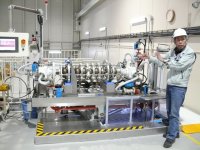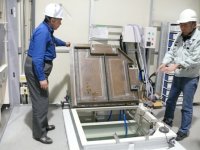 |
 |
|||||||||||||
|
|||||||||||||
|
|||||||||||||
|
Superconducting cavities are the core, the heartbeat of the International Linear Collider. Their inside will be polished to literally make them sparkle without any speck of dust or crack because these could cause a decline of performance of the accelerator. There are several methods to polish the inside of the cavities, and electropolishing (EP) is one of them. The new EP system at KEK has started its test-run in January, and scientists are gathering basic data to evaluate the machine's capability.
“Safety is our first priority,” said Motoaki Sawabe, the chemical and safety specialist of KEK's Radiation Science Centre. “We are dealing with large quantities of poisonous substances in KEK,” he said. Generally, electropolishing uses a combination of rectified current and a blended chemical electrolyte to remove flaws from the surface of a metal part. KEK's EP system uses a mixture of concentrated sulphuric acid and hydrofluoric acid as its electrolyte; both are substances whose control is obligatory under the Japanese Poisonous and Deleterious Substances Control Law. Therefore, an environmentally-friendly noxious gas and waste solution treatment was one of the most important factors in the design of the EP system, as well as human safety. The EP system consists of three machines: the electropolishing machine, an ultrasonic rinsing machine and a high pressure rinsing machine. “Most of the operation process is done automatically to ensure the safety,” said Yoshisato Funahashi, Engineering Coordinator of Mechanical Engineering Centre at KEK. First, the cavity is set into the EP machine. The cavity setting and removal are the only processes done by human hand. The cavity is filled with an electrolyte and a current passes from the anode and dissolves any rough niobium on the surface of the interior. After the polishing, the machine moves the cavity into a vertical position to empty the electrolyte, then a crane will carry the cavity to the next step, the ultrasonic rinsing machine. “It looks like a refreshing bath for us, too, but it might be too hot,” said Funahashi. The cavity will be soaked into the tub filled with hot water at 50 °C to clean both sides of the cavity with ultrasonic waves. Finally, the cavity will be lifted to the third step for high-pressure rinsing. After the rinsing with bursts of ultra-pure water, the cavity will be moved directly into the cleanroom for assembly. This automation system is also aiming for future industrialisation, making it a model for the industry. In fact, the industry is already participating in an actual test now. “We designed the EP process in a one-way system transfer to avoid any mistakes. We also wanted to ensure the working space for the workers' safety,” said Funahashi. These made the size of the EP facility so big. There were compromises in design due to the restrictions such as funding or the structure of the existing buildings. “As an engineer, I am not completely satisfied with this machine yet. I would like to make some changes to improve the machine's ability,” he added. Another reason to make this facility big are the scrubbers for noxious gasses, which are needed to make sure their concentration is low enough not to harm the environment. “I believe that the accelerator is the one big system including those systems which protect workers and the environment”, said Sawabe. The facility passed the regular working environment test designated by law recently. The result of the polishing test will be come out in the middle of this year. -- Rika Takahashi |
|||||||||||||
| © International Linear Collider |


